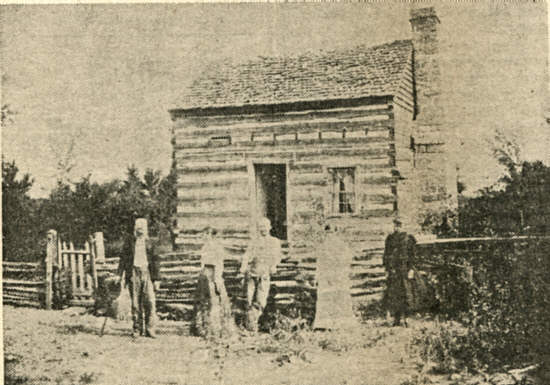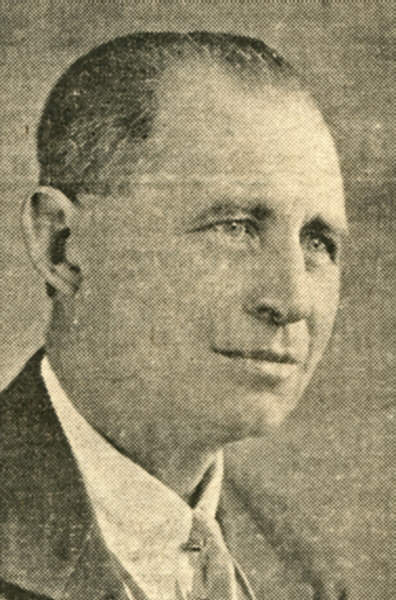
  THE SPEARMAN HOMESTEADThe Iberia Sentinel, August 19, 1937 Spearman Homestead Many old time Miller countians will recognize this picture as the old Spearman place, as the house stood for more than fifty years beside the Iberia-Brumley road near where it crosses the Barren Fork Creek. It was built by a Mr. Creed Biggers and sold to T.W. Spearman about the time it was completed, as the Spearman family was the first to reside in it. Fred Spearman, a grandson of T.W. Spearman, says this picture was taken by one Buckner, a traveling photographer, in or around the year 1897. The parties in the picture are J.W. Spearman, W.K. Spearman, Cornelia Spearman, uncles and aunt of Fred, and a couple of his cousins, Lucinda Bear and Maud Salsman. The view of the picture is looking due north. In giving a further description of the old building, our Representative, Mr. Spearman says:  Fred Spearman "The original house, as I remember it, consisted of the building shown in the picture with another log building on the north side set back about sixteen feet so as to form a room between the buildings and then roofed over with the ridge of the roof running crosswise to the roof on the building, with a porch along the west side of the building, also it had a chimney. This latter part of the house was torn away and a lean-to side room built many years before the picture was made." "Time has completely blotted out the scene, as the house is gone and the landscape so changed that none but one with an interested memory could recognize the place where it stood. But it is a picture that will never fade from my memory as long as I live, as it is the scene of my early childhood. If I remember correctly, I was the last person to be born in this house, and the greater part of the first six or eight years of my life was spent in and around it, and a great deal of time I spent there as long as it was in use. It was vacated about the year 1900 and was demolished about 1912 or 1913." "Mr Biggers was a carpenter and cabinet maker, and was an expert in the construction of this kind of buildings and done what was considered at the time an extra fine job, and when the house was completed it was considered the last word in house building in this country, as there was none better, and it stood for years as a landmark for the surrounding country. Iberia, Brumley, Crocker and such places had not yet appeared on the scene." "I have heard the folks recount how that Mr. Biggers spent the greater part of two years getting the materials together for the building. You will understand that there was no lumber yard available in the country at that early date and it was necessary for him to go to the timber and hew out logs for the wall. This was done by chopping down trees about 16 to 18 inches in diameter and hewing them into beams about eight or ten inches thick and as wide as the tree was thick. They were about twenty feet long." "Next he made the shingles from pin oak trees by riving boards and shaving them thin at one end. These two jobs were done first so that the logs and shingles should be seasoned when he went to build. Next he procured logs and with a whip-saw sawed out the joists, beams and other dimension stuff and material for the stairway." "The limestone had to be quarried for the foundation and chimney, then the scraps of stone from the quarry were burned in a lime kiln to obtain lime for the mortar for the foundation and the chimney and for pointing the building. Then he made a trip with ox teams to some place in southeast Missouri to get dressed tongue and grooved pine timber for the floor and doors. This must have been an event within itself. After this assembling of the materials he invited the neighbors for many miles around to the house raising and a big dance and dinner all night. No doubt they had something to drink too, as in those good old days of old they had not so much as heard of prohibition, cigarettes, automobiles and a lot of other modern afflictions that almost drive us to distraction I these modern days of higher civilization." "Uncle Charley Adams, who lived a close neighbor to the Spearmans all his life, once gave me an account of the erection of this house, along with a very good account of the dances given on occasion, one at the house raising and the other at the house warming. When the house was finally completed, as I remember it, Uncle Charley had a romance at the last dance by making a hit with his first wife." "After the house raising another year was spent in completing the building. It had to be roofed, the floor, doors, windows and stairway put in place, the walls chinked and pointed with mortar, and last but not least, the chimney had to be built. This was quite an institution in itself, but to me as a kid it was the royal road to Santa Claus. The chimney of the fireplace as it was called from the inside of the house was very beautiful with its arch of seven stones, three on each side and a key stone in the center, with the jams and other stones cut to fit so nicely they scarcely needed any mortar between them." "I have never seen anything like it in any other chimney, and the ponderous stone hearth on which I played as a kid I remember the rats had gnawed a small hole in the floor near the edge of the hearth. This was a lot of grief to me as I was always losing something down it. Many a small coin, pocket knife, pencil and other small boy treasures have I let slip down that rat hole never to be seen again. The chimney from the outside of the house was an imposing structure perhaps thirty feet high, and the character of the workmanship can readily be seen in the picture." |
||

|
P.O. Box 57 Tuscumbia, MO 65082 http://www.MillerCountyMuseum.org © 2007 - Miller County Historical Society |

|